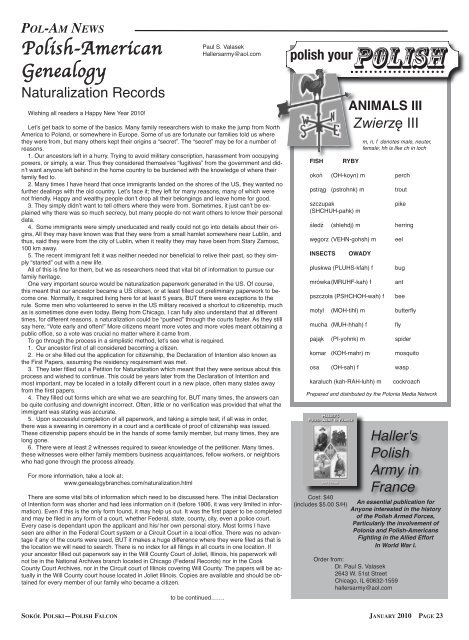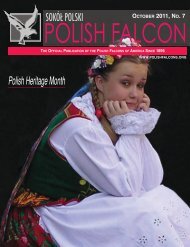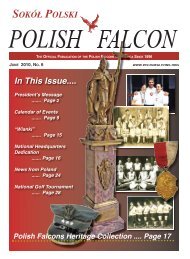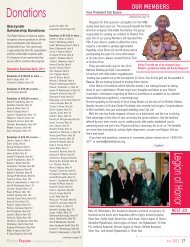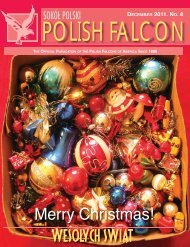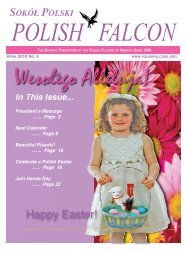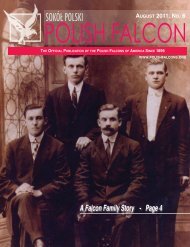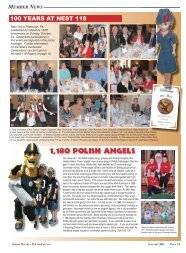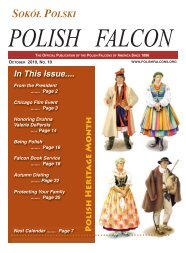POL-AM NEWSA Polka CelebrationBy Peter DanielczukNest 36, Southwestern Conn.January is National Polka Month and it is a good time to attend one ofyour local polka dances to show your support. It is also a good time to buy anew Polka CD for your listening pleasure. It is important to show your supportto our great music.As reported earlier, you know that the Grammy Award for Polka was eliminatedand that polka recordings could be entered in the Best Traditional FolkAlbum (vocal or instrumental) category. The five final nominations for thiscategory were announced and Jimmy Sturr was one of them for his recordingentitled "Polka Cola: Music That Refreshes” on the Star Record Label.The Grammy Awards will be given out on Sunday January 31, 2010. Let'sall wish Jimmy good luck on winning another Grammy to show the world thatPolka is not dead.Starr Records has just re-released two CDs in one, called DoubleMagic. The two CDs, originally released in 1990, paid tribute to the music ofBernie Witkowski, one of the most popular polka bands of the 1950s and60s. The CD features not only the Jimmy Sturr Band but the clarinet of JoeMagnuszewski and the accordion of Gene Bartkiewicz, who both performedwith Jimmy during that period. The cd features 24 songs: 17 instrumentalsand seven vocals, and is available from Starr Records, Box 1, Florida, NY10921. It's definitely "Double Magic" at its best.Polkas United, a new free online forum that is designed for all aspects ofpolka music and the people familiar with polka music, is now available on theinternet at www.polkasunited.com. Using technology of the internet, theforum is available to help those who love polka music, unite. It is organizedin a way in which everyone familiar with polkas can share some of theirthoughts, voice comments, and read comments from other people with similarinterests. Visitors can offer their two cents on polkas, polka music, polkadancing, the state of the polka industry and more. They can post comments,thoughts, feelings and opinions and let their voices be heard. Polkas Unitedinvites everyone to discuss polka music so this music genre can move forwardand grow. Join with others to have a positive conversation and increasethe popularity of polka music. Over 200 people have becomemembers as of June 2009. Polkas United is not a polka club or polka organization.No one stands to profit from this endeavor. It is a place whereeveryone can use their computers and the internet to talk about all segmentsof polkas. All generations of polka fans, dancers, musicians, promoters,DJ's, club owners, news writers, composers, record producers, recordingstudios and more are welcome to join those already on the forum. MusicianMike Stapinski is the originator and administrator of Polkas United. Email:forum@polkasunited.comJimmy "Squeezie" Soldridge of Chicago recently passed away of a massiveheart attack. He was an accomplished musician and master accordionist,having made appearances at various festivals in Europe, Canada,Mexico and the United States. His admiration for "America's Polka King,"Frankie Yankovic, would be his inspiration and love for Austrian/Slovenianmusic. Soldridge's music went from recreational to professional, when heperformed with his own band, The Happy Yanks. Soldridge also promotedpolkas on WWVA radio in Wheeling, VA with Judy Stringhill.The Dana Library of Polka vinyl records from decades ago is being restoredand is expected to be available in several months. As with other remasteredrecordings, the restored versions could sound even better than theoriginals. We will keep you updated on this project.A new Slovenian-Style polka show has been added at the Polka JammerNetwork. Called the "Slovenian Polka Hop,” it is hosted by Jim Kucharskiand features the best in Slovenian style accordion-button box polkas andwaltzes. The show will air on Monday afternoons from 1:00 PM to 2:00 PMEDT. Catch it on www.polkajammernetwork.org.The International Polka Association (IPA) has initiated its own channel onYouTube at www.youtube.com/user/ipavideo. For starters, it offers video offive bands that appeared at the 2009 IPA's Festival including Lenny Gomulka& Chicago Push, John Stevenson's DoubleShot, Tony Blazonczyk &New Phaze, Jerry Darlak & Buffalo Touch and Polka Family.The Joey Tomsick Orchestra of Cleveland took top honors at the 22ndAnnual Awards Ceremony presented by the National Cleveland-Style PolkaHall of Fame and Museum. The band, which celebrated it's 25th Anniversaryin 2009, triumphed in all five categories in which it was nominated.Band leader Joey Tomsick was named Musician of the Year, while bandmembers Phil Hrvatin and Hank Guzel Jr. recieved the award for Sidemen ofthe Year. In 2009, the Joey Tomsick Orchestra released it's long awaited CD"Polka Funhouse" which was named Polka Album of the Year, as voted bythe membership of the Polka Hall of Fame. The title track of the Album wonfor Best Original Song of the Year. The Polka Funhouse CD features 16 selections,about half of which are new or originals. You'll find several buttonbox tunes, some snappy new polkas, delightful walzes, the beautiful"Grandpa" song, and the hot Polish-style selection "What Would I Do WithoutYou". You may purchase the award-winning album directly throughJoey's website at www.joeytomsick.com.Our friend John Gora of Canada reports the Hank Guzevich of PolkaFamily was a hit at Pod Papugami (Under the Parrots) Club in Wroclaw,Poland, when he sat in with a popular blues band. "They wanted to test himout when they played the first song in concert," wrote Gora, who is alreadyplanning another trip this year to Poland, "but Hank had no problems."Another great friend, Bill Flynn of the Bill Flynn Polka Show from COOL100 invites you for free style cruising on the Norwegian Spirit from April 11-23, 2010. This "Caribbean Escape" starts in New Orleans with stops inCosta Maya, Santo Tomas DeCastilla, Aruba, Curacao, Hamilton and ends inBoston. For more information call 607-722-2228 (ext 403) or 1-800-690-2261.The Marshfield, WI Convention & Visitors Bureau is sponsoring a Dance& Romantic Weekend on February 12 & 13, 2010 at the Eagles Club inMarshfield, WI. Lenny Gomulka & Chicago Push will play on Friday from8:30 PM to 12:30 AM and on Saturday from Noon to Midnight it will be CraigEbel & DyVersaCo, Chad Przybylski & His Polka Rhythms, a Polka JamSession and Lenny Gomulka. Hotel packages available at www.visitmarshfieldwi.comor by calling 1-800-422-4541 for more information.Polkaman Jack Baciewski who was the founder of The Polka JammerNetwork (with whom I also was a founder) has come up with a new PolkaMusic Internet Network called "Polka Legacy". This exciting new networkwill feature past as well as current polka music plus many other styles ofpolka. I have signed up with Jack to do my Polka Celebration Show and Iwill be on live on Sunday Nights from 8:00 PM to 10:00 PM. Many excitingfeatures are planned for the future. I will keep you updated. Go to www.polkalegacy.com.I will also continue to do my show on 247polkaheaven.comas well as my Saturday morning show on 88.7 FM WNHU from the Universityof New Haven (www. wnhu.net) from 10:00 AM to 12 Noon.A new CD entitled Jammin' At The Cabin has been released by the PolskieSwingmasters & Friends. This CD contains 16 songs and is $15.00each plus $2 for shipping and handling. Make check or money orderpayable to Steve Brill and send to Steve Brill, 112 Maple Drive, Drums, PA18222 or Email: stevbril@ptd.net.Polka Band leader John Gora will be your host MC aboard CarnivalCruise Lines newest ship "Dream" on a great Caribbean Polka Cruise fromOctober 23-30, 2010. This cruise will leave Port Canaveral, FL and visit theIslands of Nassau, St. Thomas and St. Maarten. Headliners include JimmyK, Bruno Mikos, Stephanie, Jersey Polka Ritchie and Stas Golonka. Bandsinclude Mass Brass, New Direction, Craig Ebel & DyVersaCo, The Wave andThe Varitones. For more information and flyer call Dave Bonczkiewicz (NickelcityDave) at 1-602-741-8214 or go to www.nickelcitydave.com.Until next time, take care and God Bless. Remember we are all one family,all one big polka family. God Bless Poland and God Bless America.Czolem,Druh PeterSOKÓŁ POLSKI—POLISH FALCON JANUARY 2010 PAGE 22
POL-AM NEWSPolish-AmericanGenealogyNaturalization RecordsWishing all readers a Happy New Year 2010!Let’s get back to some of the basics. Many family researchers wish to make the jump from NorthAmerica to Poland, or somewhere in Europe. Some of us are fortunate our families told us wherethey were from, but many others kept their origins a “secret”. The “secret” may be for a number ofreasons.1. Our ancestors left in a hurry. Trying to avoid military conscription, harassment from occupyingpowers, or simply, a war. Thus they considered themselves “fugitives” from the government and didn’twant anyone left behind in the home country to be burdened with the knowledge of where theirfamily fled to.2. Many times I have heard that once immigrants landed on the shores of the US, they wanted nofurther dealings with the old country. Let’s face it; they left for many reasons, many of which werenot friendly. Happy and wealthy people don’t drop all their belongings and leave home for good.3. They simply didn’t want to tell others where they were from. Sometimes, it just can’t be explainedwhy there was so much secrecy, but many people do not want others to know their personaldata.4. Some immigrants were simply uneducated and really could not go into details about their origins,All they may have known was that they were from a small hamlet somewhere near Lublin, andthus, said they were from the city of Lublin, when it reality they may have been from Stary Zamosc,100 km away.5. The recent immigrant felt it was neither needed nor beneficial to relive their past, so they simply“started” out with a new life.All of this is fine for them, but we as researchers need that vital bit of information to pursue ourfamily heritage.One very important source would be naturalization paperwork generated in the US. Of course,this meant that our ancestor became a US citizen, or at least filled out preliminary paperwork to becomeone. Normally, it required living here for at least 5 years, BUT there were exceptions to therule. Some men who volunteered to serve in the US military received a shortcut to citizenship, muchas is sometimes done even today. Being from Chicago, I can fully also understand that at differenttimes, for different reasons, a naturalization could be “pushed” through the courts faster. As they stillsay here, “Vote early and often!” More citizens meant more votes and more votes meant obtaining apublic office, so a vote was crucial no matter where it came from.To go through the process in a simplistic method, let’s see what is required.1. Our ancestor first of all considered becoming a citizen.2. He or she filled out the application for citizenship, the Declaration of Intention also known asthe First Papers, assuming the residency requirement was met.3. They later filled out a Petition for Naturalization which meant that they were serious about thisprocess and wished to continue. This could be years later from the Declaration of Intention andmost important, may be located in a totally different court in a new place, often many states awayfrom the first papers.4. They filled out forms which are what we are searching for, BUT many times, the answers canbe quite confusing and downright incorrect. Often, little or no verification was provided that what theimmigrant was stating was accurate.5. Upon successful completion of all paperwork, and taking a simple test, if all was in order,there was a swearing in ceremony in a court and a certificate of proof of citizenship was issued.These citizenship papers should be in the hands of some family member, but many times, they arelong gone.6. There were at least 2 witnesses required to swear knowledge of the petitioner. Many times,these witnesses were either family members business acquaintances, fellow workers, or neighborswho had gone through the process already.For more information, take a look at:www.genealogybranches.com/naturalization.htmlThere are some vital bits of information which need to be discussed here. The initial Declarationof Intention form was shorter and had less information on it (before 1906, it was very limited in information).Even if this is the only form found, it may help us out. It was the first paper to be completedand may be filed in any form of a court, whether Federal, state, county, city, even a police court.Every case is dependant upon the applicant and his/ her own personal story. Most forms I haveseen are either in the Federal Court system or a Circuit Court in a local office. There was no advantageif any of the courts were used, BUT it makes a huge difference where they were filed as that isthe location we will need to search. There is no index for all filings in all courts in one location. Ifyour ancestor filled out paperwork say in the Will County Court of Joliet, Illinois, his paperwork willnot be in the National Archives branch located in Chicago (Federal Records) nor in the CookCounty Court Archives, nor in the Circuit court of Illinois covering Will County. The papers will be actuallyin the Will County court house located in Joliet Illinois. Copies are available and should be obtainedfor every member of our family who became a citizen.to be continued…….Paul S. ValasekHallersarmy@aol.compolish your PolishFISHANIMALS IIIZwierzę IIIRYBYm, n, f denotes male, neuter,female; hh is like ch in lochokoń (OH-koyn) m perchpstrąg (pstrohnk) m troutszczupak(SHCHUH-pahk) mpikeśledź (shlehdj) m herringwęgorz (VEHN-gohsh) mINSECTSOWADYpluskwa (PLUHS-kfah) fmrówka(MRUHF-kah) fpszczoła (PSHCHOH-wah) feelbugantbeemotyl (MOH-tihl) m butterflymucha (MUH-hhah) fPrepared and distributed by the Polonia Media Networkflypająk (PI-yohnk) m spiderkomar (KOH-mahr) m mosquitoosa (OH-sah) f waspkaraluch (kah-RAH-luhh) mCost: $40(includes $5.00 S/H)cockroachHaller'sPolishArmy inFranceAn essential publication forAnyone interested in the historyof the Polish Armed Forces,Particularly the involvement ofPolonia and Polish-AmericansFighting in the Allied EffortIn World War I.Order from:Dr. Paul S. Valasek2643 W. 51st StreetChicago, IL 60632-1559hallersarmy@aol.comSOKÓŁ POLSKI—POLISH FALCON JANUARY 2010 PAGE 23


